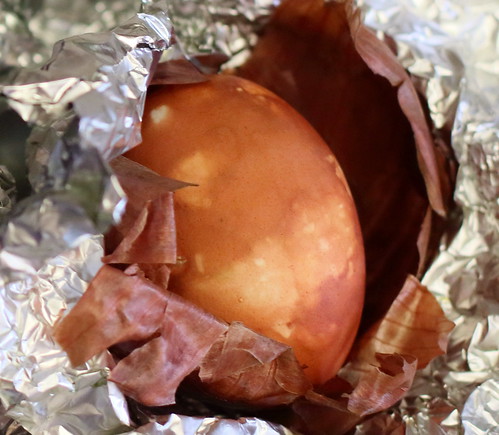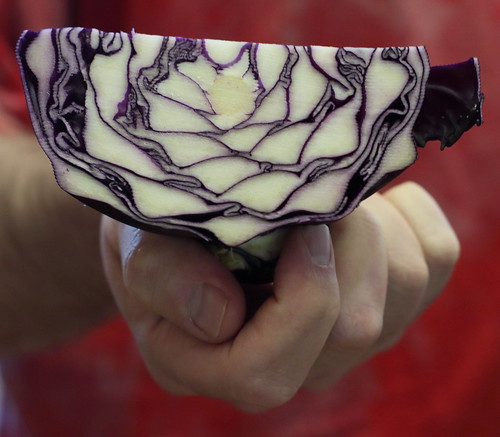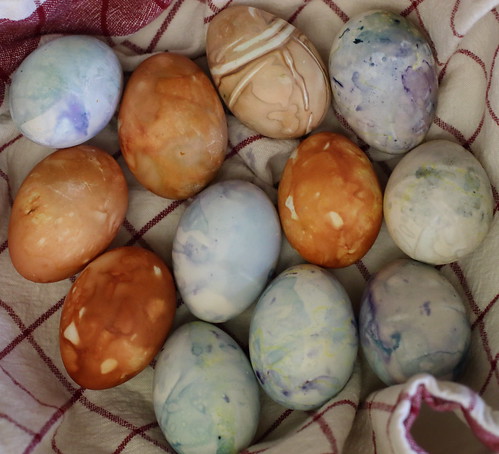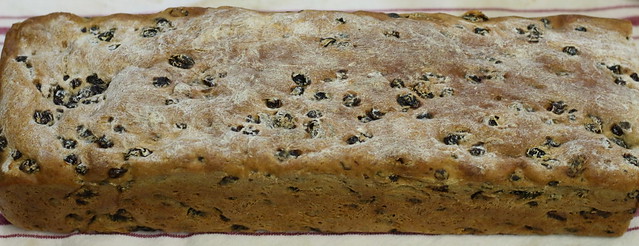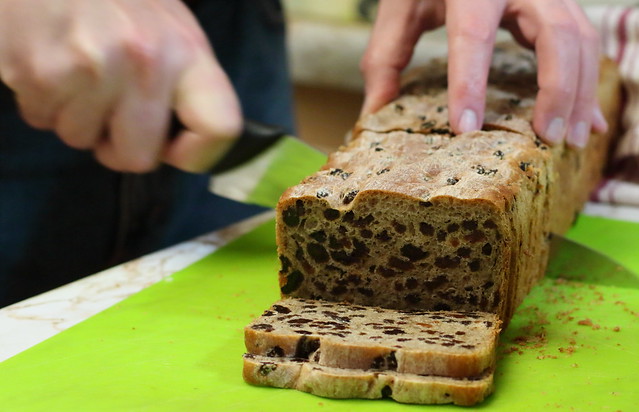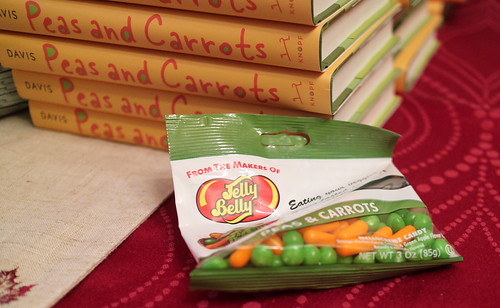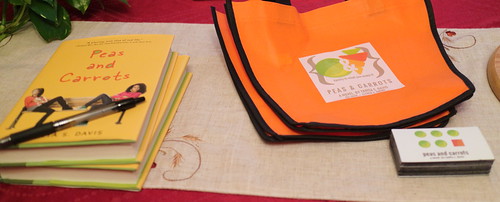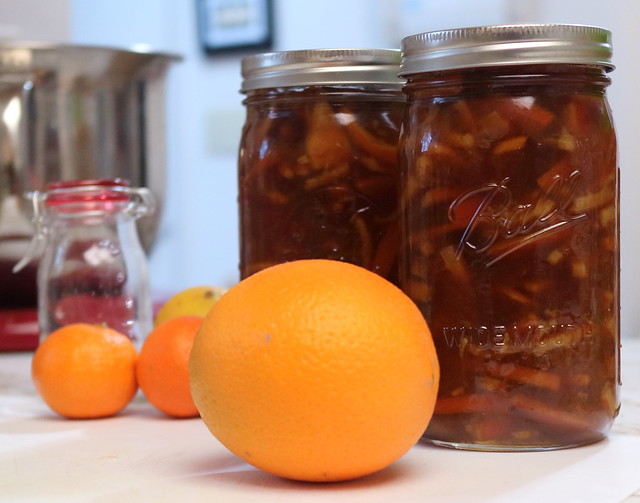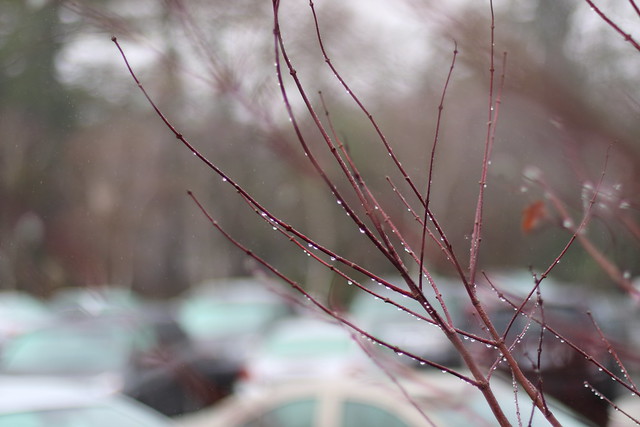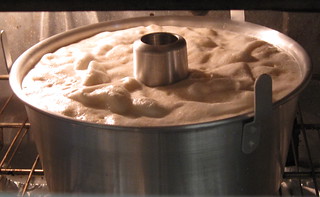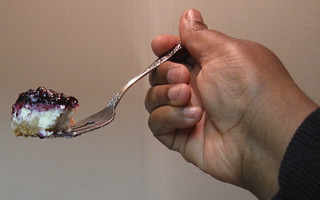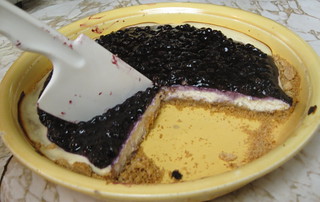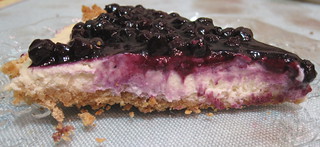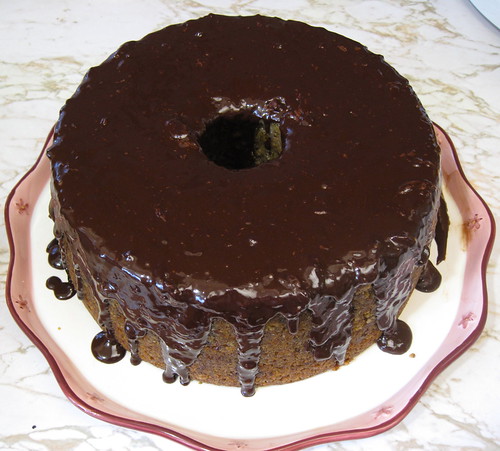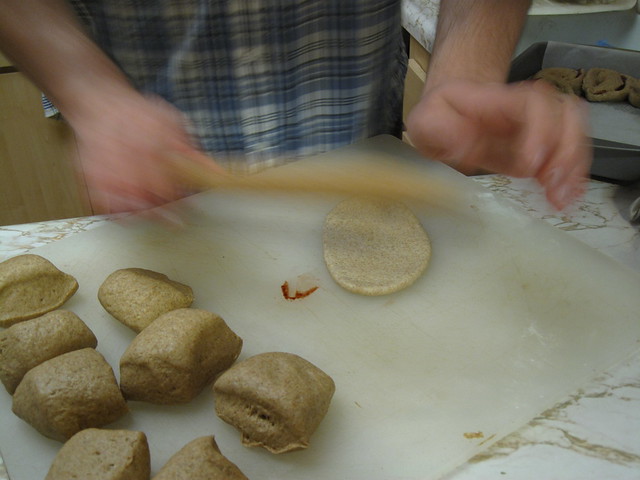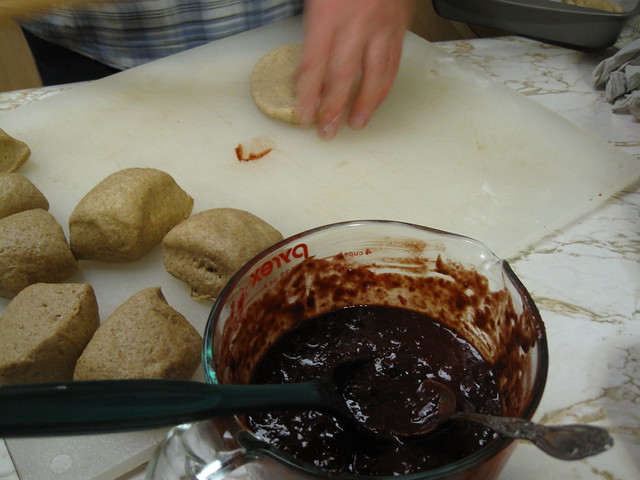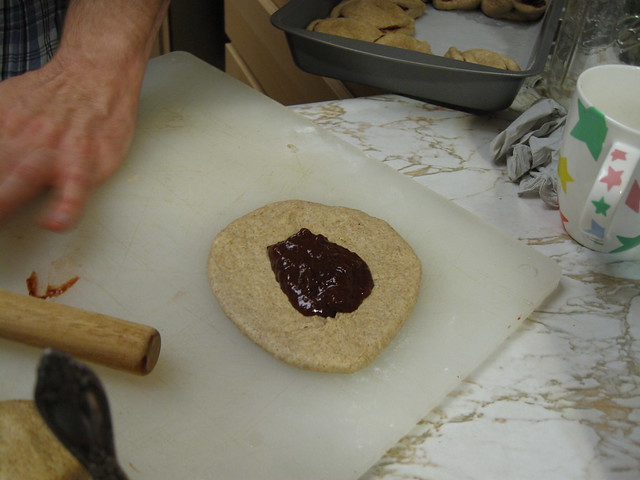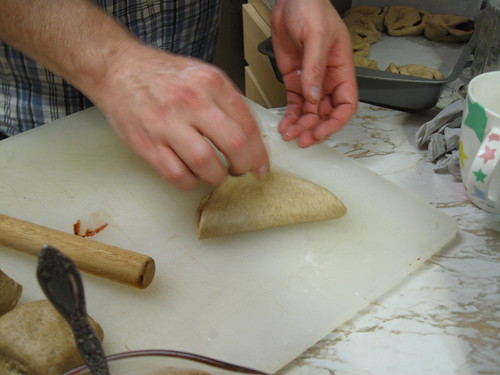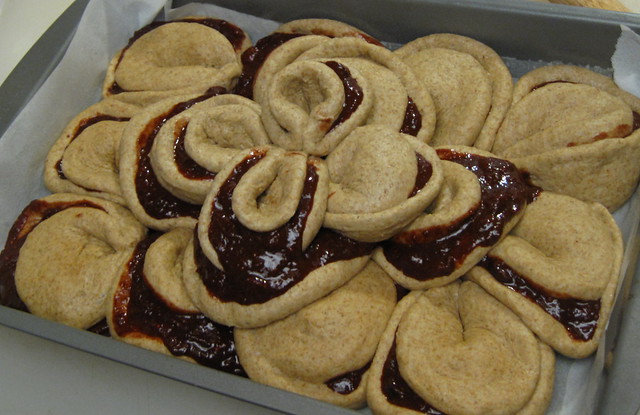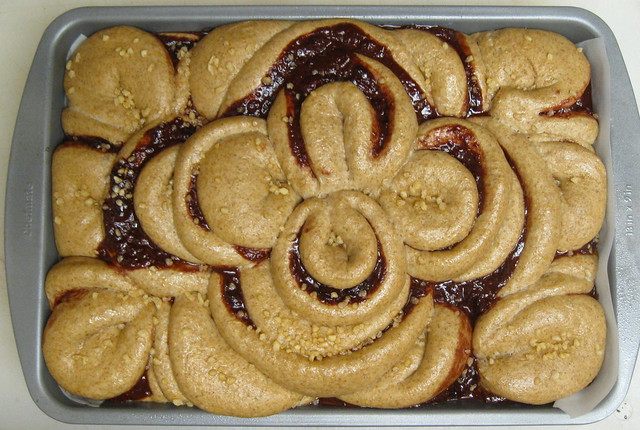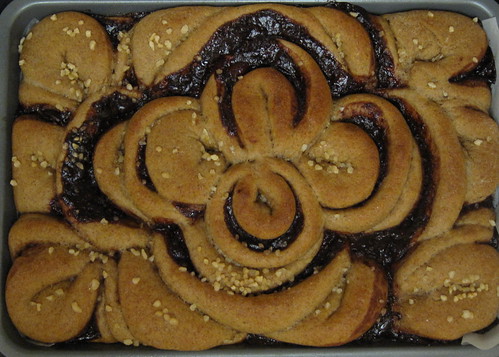Pied Beauty
~ by Gerard Manley Hopkins (1844-1889)
Glory be to God for dappled things—
For skies of couple-colour as a brinded cow;
For rose-moles all in stipple upon trout that swim;
Fresh-firecoal chestnut-falls; finches’ wings;
Landscape plotted and pieced—fold, fallow, and plough;
And áll trades, their gear and tackle and trim.
All things counter, original, spáre, strange;
Whatever is fickle, frecklèd (who knows how?)
With swíft, slów; sweet, sóur; adázzle, dím;
He fathers-forth whose beauty is pást change:


First published in 1918, the above poem can be found in:
New York: Oxford University Press, 1986.
New York: Columbia University Press, 1998.
‘I’ll to thee a Simnell bring,’ Part i
A great deal can change in a short time. Contracts can be changed, lives or health can be lost, and vacation plans altered mid-stride. We’ve all lived it.
What’s weird is how rarely that impacts our daily world. Most of the time, things change realllllly slowly. At the speed of glacial snails. We’re dying for Something To Happen, and …nothing much does. That, too, is life.
Culinarily, change is never swift. A recipe from the 15th century still today can bear the echo of its roots. Take, for example, the Simnel cake. This is an old, old English Easter cake, mentioned in a 17th century Herrick (1591-1674) poem from 1648. ‘I’ll to thee a Simnell bring ‘Gainst thou go’st a mothering, So that, when she blesseth thee, Half thou’lt give to me.’ The narrator (we assume Robert Herrick) confides that he’ll bring his friend a Simnel cake, so that, on the festival day of Mothering Sunday, which is the fourth Sunday of Lent, he’ll receive half of her blessing. Interestingly, Mothering Sunday can allegedly be traced back to the Greeks celebrating a three-day festival of the goddess Cybele, mother of all gods. Rather than celebrating motherhood, the festival apparently celebrates the Mother Church. Used as part of Mothering Sunday celebrations through Britain and beyond, it’s a specialty because Mothering Sunday, or “Refreshment Sunday” as it’s also called, relaxes the strict fasting rules for Lent. Thus: cake!
Sounds good to us.
More information we ferreted out: the word simnel is from Old French simenel, or spelled seminel, based on Latin simila, meaning fine flour. In Greek semidalis means finest wheaten flour, and an old Assyrian word, samīdu and the Syriac word sĕmīdā, mean fine meal. (Semolina, anyone? It’s the same root. Also semmel in German means a bread roll.) Thus, we know that this Simnel cake is made with finely milled flour, probably white, or as close to white as a household could get. It was studded with dried fruits – what was available at the beginning of Spring, leftover from winter – and heavily seasoned. Some recipes call for it being both boiled AND baked. Of course, boiling is traditional for many Scottish cakes, as boiling was all some households had. Few working people had ovens in the 18th-19th century, and cooked in a kettle over a fire, or on a hearth. However, there’s a goofy legend attached to this — a man called Simon and his wife Nell argued over whether the cake for Mothering Sunday should be baked or boiled. Too keep peace, they did both, so the cake was named after both of them: Sim-Nell. Aaand, we don’t believe that at all, but it’s convenient fiction to explain why some recipes call for both methods of cookery.
Our first shot at this cake comes from England. We used the hand-written recipe recorded between 1705 and 1726 blogged at Cooking in the Archives. The recipe is held at the University of Pennsylvania library, and calls for ingredients like “a peck of flour” “a race of Ginger” “Balme,” which was the wild yeast found floating atop fermenting beer, and “sack,” which is kind of like sherry. We didn’t have spirits or fermenting anything in the house, so skipped that step. We noticed that this old recipe did not call for marzipan or peel or anything like more modern Simnel recipes call for, but we made sure to honor the “fine flour” aspect of it by using a strong white bread flour. We substituted the “boyl” – er, boiling for a long, slow rise in a slightly warmed oven. This was a necessity, as it’s still pretty cool here of an afternoon and evening, and the nights are crisp, and this bread just didn’t otherwise want to raise. This could also be blamed on the absolute stuffing of raisins and currants. This stuff is LOADED.
Rode hard, put up wet, still smiling
Friends in the East are having very different weather than ours today. “Oh, spring has sprung,” one said Tuesday. “The rest is just details.” Another crowed on her blog the other day, “The air is glorious like wine! Saw my first tiger swallowtail, and all the frogs are singing!”
Our friends are reveling in their gardens, sitting on front stoops with cider and books, and stretching their limbs in the sun. “Must be nice,” we sigh, as another gust of wiiiind slaps a handful of rain into our faces, but then we look over our shoulders nervously. We are NOT, repeat, NOT tired of the rain. No, no! Californians who whine are subject to lightning strikes about the head and shoulders, so we are NOT whining, not when we’ve finally seen a light at the end (well, the beginning of the end) of the nastiest drought tunnel in years. Even in the face of a potential Category 3 storm (the weather person who said this was met with bewildered, “What?” faces), we are sucking it up to relearn appropriate rain behavior. We first met this in Seattle, and really learned the ropes in Scotland. The Just Do It school of rainy weather behavior is “if you let the rain chase you indoors, you’ll never come out again ’til July,” so we’re managing the trick of being out/about anyway when we’d rather stay in and read and bake and schlepp around the house. One of the ways we keep moving, as Lake Shasta and the reservoirs, creeks and rivers are filling – or in poor Sebastopol/Guerneville/Monte Rio’s case, overfilling AGAIN – is to step outside and remember one of the ten thousand reasons to be happy right now.
So, go outside. We’ll wait.
You out there? Good. Listen.
In the daytime, in between the soughing of the wind and the plink and prickle of raindrops against the earth (and the unfortunate wail of sirens, as people collide and slide across the road) you can hear something else. Birdsong. Millions of birds, tweeting and squeaking and singing. And, of an evening, you can hear this:
Okay, this is two hours from our house, on the edge of a meadow facing a great thousand acre swath of woods, true, but the frogs are singing at our house, too- even in the damp and cold and wet (why would that make a difference to them??) – singing. Singing aloud – I’d say with joy, but no point in waxing ridiculous; they’re singing aloud with an “I’m an available mate” tune going on. 😈 It’s what Spring is all about.
As the traffic snarls and you watch the eejits in front of you speed, then hydroplane and fishtail up the road (note to people who own pickups – in high wind and rain, put something in the truck bed; didn’t they tell you that in Driver’s Ed???), remember the birds. Remember the frogs. Drive carefully, stay out of the wind, if you can, and remember to take a little bit to listen – and be grateful.
Happy storm weekend.
Aside from reading for a book award, reviewing other books and pretending to be a competent writerly being…
…I’m up to a few other things:
February is not just when the groundhog emerges (albeit with a LOT of help from people pulling it) from its hole to find its shadow – it’s apparently the month when introverts Make An Effort (also with a LOT of help from people… pulling). I’ll be booktalking, and being visible this February here and there – first, I’m presenting a webinar February 2nd for The National WWII Museum on Mare’s War as part of their WWII emphasis this year. Teachers and families who do homeschooling, you’ll want to jump on this! The week following, I’ll be on the blog STACKED and then the tumblr Size Acceptance in YA; at BN Teen Blog’s Open Mic project sometime next month, and on John Scalzi’s WHATEVER blog’s Big Idea project on February 9th, which is the same day that PEAS AND CARROTS has its book birthday.
I’m grateful to everyone who asked me to show up and hang out next month, and given me the opportunity to talk about what I do and how I do it.
X-posted from {fiction, instead of lies}
– T
{the people that walked in darkness}
when you walk through the storm, keep your head up high,
and don’t be afraid of the darkAt the end of a storm is a golden sky, and the sweet silver song of the lark –
…Walk on through the wind, walk on through the rain
though your dreams be tossed and blown –Walk on, walk on, with hope in your heart
and you’ll never walk alone… you’ll never walk alone.
To the people still walking in darkness, and waking in darkness, and whose spirits are flattened beneath the hideous orangish glow of sodium lights — hang in there.
And to those who are buckling down for wind, sleet, storm and blizzard this weekend — see you on the other side. Stay warm!
Citrus Season
‘Tis the season for winter blahs, endless cups of tea, difficult awakenings, and increased indolence. January lies within that particular limbo of “nothing going on yet” and recovering from too much going on. We are grateful to be healthy and to have the wherewithal to be a little bored. Bored right now is good.
2016 seems to be moving at a shocking clip — it seems inconceivable that we’re getting tax forms already, and looking at bills for car registration and insurance and all the other cyclical things that come round again and again. By this time of month, people have stopped going on about resolutions and have gone back to fearmongering about politics — what if my candidate doesn’t win? — fearmongering about the weather — what if after this El Nino, there’s another La Nina cycle with NO MORE RAIN?? — and in general bickering, unpleasant, cantankerous realities of American society. Definitely time to turn off the …everything, and go outside.
It’s odd how to think how much we’ve forgotten about a rainy season. We’ve been wakened by wind and rain more than once these past few weeks, have watched the previously dead square of yard tentatively take on a furred green aspect as tiny seeds of …something germinate. (Oh, please God, may it not be the ivy again. It took us WEEKS to dig that out. It’s probably ivy. *sigh*) Between the wooden slats of our deck, beneath the bird feeder, eight sunflowers stretch bravely toward the leaden sky. They’re all about four inches tall, but distinctive. If we could transplant them, we would. The dying pine trees — still standing, because the owner can’t decide on a company to come and remove them — seem like they’re shedding pine needles in thick carpets in order to provide hiding places for the tiny, darting birds which have multiplied by the hundreds. Even the hummingbirds – suspiciously hovering and glowering at all comers – have slowed their usual frantic circling to simply sit in the yard and watch this season unfold.
The Wees are selling oranges at their elementary school, and while our weekly farm box provides us with plenty of cabbage, root veg and citrus, we agreed to buy a bag. In the spirit of trying to use everything in the veg box that we can — we’re still making kimchi and pickling carrots and cauliflower — T. bodged a bunch of oranges in a pot the other afternoon and decided to make marmalade.
We’ve been in the marmalade frame of mind before. It didn’t go well. D. worked so hard to thinly slice oranges and lemons and carefully weigh out all the ingredients… and it never set. Worse, it bubbled over and made a mess, and we ended up tossing a lot of it after we scraped it off of the stovetop. This time, T. sliced the oranges by hand instead of with a mandolin, added some cloves, just because, put in a random amount of sugar, and … mainly forgot about it. This we call “serendipitous cooking.” As in, it’s serendipity that it didn’t scorch, boil over, otherwise implode, and it’s actually good. It worries T. when she manages things that D. hasn’t managed… mainly because she can’t figure out how it happened.
Marmalade aficionados suggest softening rinds with a long, liquid reducing boil, not overstirring the marmalade after it’s reached a boil, potting the jam when it’s warm, and not piping hot, and making sure the thinly sliced citrus fruits are not too thin. British marmalade is made with the peel separated from the fruit, but T. didn’t bother zesting the oranges, and ended up turning them off midway through the cooking process for an appointment. Putting them back up to boil afterward may have done good things for the pectin formation. Some marmalade makers add the sugar near the end of the procedure, to keep the end product clear and brighter in color. Others add brown sugar, to create a deeper flavor. Since we have a whole haul of frozen and sliced oranges in the freezer, we look forward to trying out a few of these ideas.
As it stands, this marmalade is quite good, reminiscent of the bittersweet and sticky Dundee marmalade we liked so well in Scotland. T promises next time to pot it in much smaller jars for sharing — until then, she encourages you to prep and freeze your own citrus glut; you never know what wonderful things marmalade can make better. D. likes it drizzled over pound cake or as a layer in a chocolate cake. Eventually, once we pull ourselves together to try angel food again, it will also go well with that…
A hazy winter sun is emerging from behind a bank of gray-edged clouds. A piquant tanginess elevating winter’s earthy root offerings, the abundant orange is a little bit of sun to offset the tough darkness of what may turn out to be a pretty long winter. For that we can be nothing but grateful.
The More Things Change
In the major house clean after the holidays, T. found a newsletter from 2005 which commented on the torrential, Ark-inducing rainfall. Those were the days, and the return of the rain to this rather dry state – this week’s “conga line of storms” as one forecaster deliriously burbled – is still too much of a novelty to provoke much complaint about the snarled traffic and the inconvenience of a sudden ploot, as the Scots call a downpour (though we WILL complain about the eejits who don’t understand that one cannot drive a wet road at the same speed as one dry). At work this week, D. discovered that his thick wool cardigan indeed smells quite like wet sheep when thoroughly drenched. Funny, that.
It’s always nice to do a bit of baking when being outdoors is not an option, and D. took the opportunity to use a recent gift of an Angel Food pan for the first time. Whether it was the lemon zest he added to the carefully folded froth or the fact that he – strictly following a recipe for once, since he’d not made an angel food cake for over 20 years – used Egg Beaters instead of cracking fresh eggs, or the Egg Beaters had frozen previously — something made this cake weirdly almost soggy, with huge bubbles, and an appalling…coarseness. Since an angel food cake is normally light, airy, firm, yet tender of crumb, this was a definite MAJOR fail – the first of the New Year, which amused us greatly. It was frustrating, but angel food is just such an easy cake that we were sort of gobsmacked that it had somehow not come out right. From Cook’s Illustrated we learned that Egg Beaters are twice pasteurized… of course, we checked with them AFTER we’d made our error. Well. Live and learn. We have some ideas for what to do next time, and will begin by using a different recipe, in-shell, non-carton egg whites… and going from there.
At least our Lavender Lemon Shortbread turned out. Of course, D. doubled both the lemon and the lavender because he feared they’d simply taste like really rich sugar cookies if he didn’t. T. felt the spices fought each other, and would have preferred one merely complementing the other, OR, Lavender sugar cookies and Lemon shortbread, separately. D. found them reasonably tasty, and T. decided, as she often does, that they’d be improved with a tart lemon frosting glaze. Lemon juice, with a soupçon of icing sugar, covers a multitude of sins.
All that needs to be added is a cuppa and a fire, and all’s well that ends well. Well…mostly. Happily D. got a new EvenGrind – a hand-powered coffeebean grinder – and while he is quite pleased with it, he and a coworker have discussed making it work with an electric drill… so, once the whirring stops, and the cuppa’s brewed, THEN all is well. Apparently.
So. A fire, a cookie, a game, and thou. Looking back at every January, wet or dry, we’re pretty much the same as we always are. Cheers to that.
The Unprepared Chef, or, How To Make An Imperfect Cheesecake
Can you bake a cheesecake without cream cheese? T. asked the internets at large on a Wednesday afternoon. She was treated to dubious silences and a chorus of “NO” by well-meaning strangers when she perused the goods in her fridge and found a log of Laura Chenel chèvre – a mild and fresh Sonoma goat cheese. “It’s too bossy,” she was warned. “Too much flavor.” That’s as may be, but when you’re stuck on a writing project and have been cooking just because a.) you’re cold and cross, and b.) you’re craving an excuse to eat blueberries, and c.) did we mention cross? you just… go ahead and make that thing. Because, cheesecake. Sometimes life is less about if you could do a thing, than if you should…
Normal people have… food on hand, in the house, and don’t need to make lightning raids on the pantry to create things out of odds and ends, but somehow, the end of the week always brings us to this weird pass. Maybe it’s just that we haven’t yet gotten into the habit of doing “big shops” for more than a few days at a time, a relic of our time in the UK when we went to the tiny market up the road daily. Maybe it’s just that we rarely have desserts that we make for ourselves (though D. frequently makes ginormous cakes and …carries them off to work) and we don’t think to have ingredients on hand. Maybe it’s just that SOMEONE is altogether too fond of cream cheese frosting for their ginormous work cakes. At any rate, T was determined to thaw some blueberries, and needed something to go with them. Enter the chèvre.
Possibly a traditional West Coast American cheesecake (sans eggs, unbaked) might not have worked out as well, but this was T’s usual kitchen sink veggie hybrid, which uses a box of Mori-Nu silken tofu to replace the additional protein and creaminess that eggs would have provided. A tablespoon of vanilla, together with half (4 oz. from an 8 oz. log) of a Laura Chenel chèvre cheese – no salt added, because chèvre is already salted – three tablespoons of castor sugar, and we were good to go. The ingredients she simply creamed together with a stick blender, and set aside.
The unprepared chef traditionally never has digestive biscuits, gingersnaps, or anything else helpful — or homemade — but there’s always that stale packet of graham crackers she got for the nephews ages ago — they’ll do in a pinch for the crust. They won’t add much flavor, so freshly ground dried ginger and/or cinnamon to the dry crushed crackers is essential. One and a half cups of blueberry mixed with a half tablespoon of King Arthur Flour dried lemon juice, two tablespoons of sugar and 3/4 tablespoon of cornstarch was stirred to a thickening boil, and set aside for later… and then T put it together, baked it – sans water bath, just in a plain oven at 170°C/350°F for thirty-five minutes until the middle still jiggled but there were signs of tightening all around the edges.
T could hardly wait for the stuff to cool. Enquiring minds now wanted to know if it was any good… and it was! The slight tangyness provided by sour cream in many cheesecake recipes for more prepared chefs is provided by the chèvre. We actually wish we had used more than half the container; the Chenel is such a mild cheese and not so assertive that we couldn’t have used more of that piquancy (conversely, we could maybe have gotten the same effect with a tablespoon less of sugar – we’ll have to fiddle with it). Maybe we’re just on a late autumn citrus kick, but T. really wished she’d added more lemon in the form of zest to the berry topping, which she added to the room-temperature cooled pie. Next time. Next time.
Until then, here’s to finding random things in the cupboards and the fridge and beating them into culinary submission.
In lieu of the pie…
Not every use of pumpkin this time of year ends in pie or a hideously over-sweetened “spiced” coffee drink of red cup fame. (There’s no pumpkin in those things, actually, so never mind…) D’s friend, Rainer, who emigrated from Germany, recently enjoyed some of D’s carrot cake and reminisced about a cake he ate growing up, made with Hokkaido pumpkins. It was, he described it, rich, dense, and spiced similarly. He then gave D. the recipe in …German. Fortunately, there’s Google.
The first thing we had to decipher is what a Hokkaido pumpkin is… and where to find one. The name easily enough identified it as yet another varietal of Japanese pumpkin, but it’s known in this part of California as a Red Kuri (or kari) squash. At our usual market we found something that looked … KIND OF like a red kuri in shape, but it was too large, and the color was more butternutty… and the grocery store brilliantly labelled it “Winter Squash.” Um. Yes. Full of detailed, helpful information, that name.
Red kuri – or Hokkaido squash – as you see in this cheater picture from Wikimedia Commons – are beautiful. Their small size and intensely colored rind are notable, and their inner flesh is kind of …pink. They’re on the sweeter side, and are carried locally at various farm markets, Whole Foods, Sprouts, and the like, though with the before-Thanksgiving run on hard squash and gourds, we couldn’t source any this time. We bought our “winter” squash for Tuesday soup and grated a kabocha instead. Another Japanese favorite, used in tempura, kabocha are hard and sweet and have the same bright orange flesh, so we figured it was a decent substitute.
Rainer’s Kürbiskuchen
200g soft butter —> 7/8 cup
150 g sugar —> 3/4
100 g of honey or maple syrup —> 1/3 c honey
4 egg yolks
500 g pumpkin flesh —> 17 oz
300g Hazelnuts —> 2 c. hazelnut flour
100 g flour —> 1 c. AP flour
1 teaspoon baking powder
1 pinch of salt,
1 teaspoon cinnamon,
nutmeg
some black pepper.
4 egg whites200 g chocolate —> 1 c
dried pumpkin seeds for garnishThis recipe records the equivalents which we used – please note that they are not exact, nor did we entirely follow the recipe, though we were as faithful as we could be.
The what-to-mix-first portion of the recipe didn’t translate very well, but once you’ve made carrot cake, you can pretty well make this. As we had a few hopeful vegans around this holiday, we opted to make the cake vegan — so we made flax eggs and used Smart Balance. We cut the butter called for by half because …well, it just seemed like a lot, and there’s really nothing worse than a greasy cake. We baked it in an angel food cake pan and were astonished at how much oil there was left still in the pan afterward. We were actually a little worried, but it all came right …
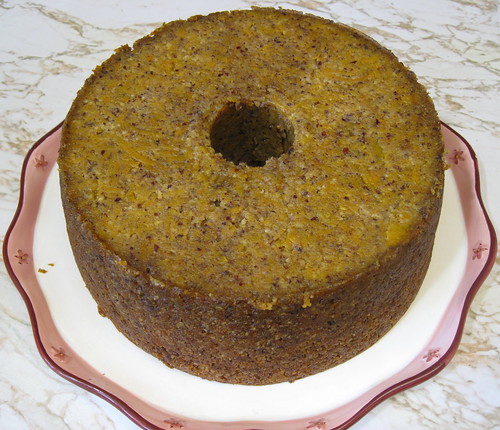 ”
” The instructions mentioned something about having chocolate flake scattered on the top of this cake. D. made a deep, rich ganache instead, and we skipped the pepita garnish because if you didn’t see pumpkin seeds, you’d have no idea that pumpkin was the flavor of the cake! Though too soft for T. – she’d like to try the recipe again with the right kind of pumpkin, with eggs, and with a different balance of hazelnut flour to AP flour, just to test some hypotheses – the cake was a hit with the guests over lunch on the weekend, and the remainder was quickly snarfed up by workmates. The ganache contrasted amazingly well with the bland sweetness of the pumpkin. This was a “ten minute cake,” it was literally gone before Rainer even got to taste any! Oh, well. Good excuse to make it again.
Anyone weary of the traditional uses of pumpkin during the holidays might swap out carrots (and raisins) in a traditional carrot cake recipe, and enjoy the results!
Baking Like the Babes: Russian Chrysanthemum Bread
When you bake bread every week, or every-other, you lose the ability to really… blog anything interesting about it. Oh, yes, this week the dough had a GREAT gluten! This week we used a little more White Whole Wheat, and a pumpernickel instead of a blended rye…. Yeah, we know we have the ability to gabble on endlessly about that sort of thing, but at the end of the day, we love you too much to expose you to our sheer nerdishness. I mean, we’re the people who peruse the King Arthur Flour catalogue over breakfast! So, we bake – a great deal – and it’s usually wholemeal bread which we use for absolutely everything – toast to sandwiches. Sometimes we’re inspired to branch out by seeing images of some wonderful thing, and that was the case this time. Blogging Baker Babe Lien is rounding up the Bread Baking Babes this month, and while we’re rather short on babe-ishness around here this week, we happily played along with this gorgeous looking bread.
Russian Chrysanthemum bread seems like one of those holiday breads that is just perfect for this time of year. The simple dough calls for using strong flour, which is simply a high gluten flour, and the recipe follows. The filling for the original bread Lien (and many others) made is savory, which you know we’ll have to try before winter is over, but you know we mavericks can never simply follow a recipe properly the first time — we made ours of tartly sweet cranberries and clementines with dark chocolate — basically leftovers from the cranberry sauce T. had just made, with shards of dark chocolate thrown in. It is a TASTY filling – not terribly sweet, not too tart, smooth and richly chocolaty. T. thought this looked like a pull-apart bread to us, but a lot of the Baking Babes – and D. – thought it made more sense to actually slice it. This bread is open to a great deal of variation – it’ll be interesting to see where it lands in our whimsy next! And we do look forward to trying it in a springform pan, or with some more flower-y shapes.
500 g strong flour/bread flour (with some extra for dusting the board when you roll out the dough)
7 g dry instant yeast
125 ml milk, lukewarm (1/2 cup)
125 ml kefir or yogurt (1/2 cup)
1 tablespoon sugar
1 teaspoon salt
1 egg
90 ml olive oil (3 oz.)
We used whole wheat flour and instead of sugar, maple syrup. We also forgot the yogurt and skipped out on the egg in the glaze and in the dough, as several guests this weekend are vegan. We’ll give it another try at some point as written.
When making her bread, Babe Elle wisely rolled her dough all out and used a biscuit cutter to get the perfectly sized rounds. Would this have made our lives much easier? Oh… sure. *cough* Maybe. Probably. However, D rolling the dough out individually suited the graduated sizes of the petals on his mums.
Overfilling the petals is really the worst thing you can do, with a loose filling – you need just a schmear of filling to show, and just enough so that it won’t squish out when you’ve pinched the dough together… it should stay in place, allegedly. T. started filling with a tablespoon initially, but switched to about a teaspoon full of filling – enough to taste, not to make a meal on (sadly). And the round of dough is simply folded in half and then the folded edges pinched together to make a petal. This would be a great job for small children with clean hands and a need desire to avoid other work and participate in the making of the treat.
We topped our bread with sugar crystals, colored with saffron, just to add a little crunch and color. Though T. really did kind of over-do it on the filling, the dough turned out to be very excited about proofing, which made the whole thing a bit more forgiving than it could have been. The tender, toothsome dough baked up looking golden-brown and delicious and was really well received by eaters of all ages this past weekend.
It’s too easy to be busy lately, and the holiday throws its own craziness into the mix of the daily things we have to do. We’d lately forgotten the fun of baking with others, so we’re grateful for the Babes for being the first to try this easy – yet complex – frilly bread. Can’t wait to try it again!
